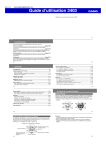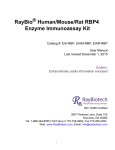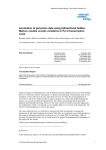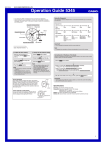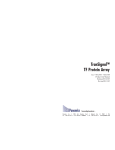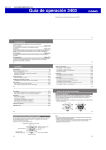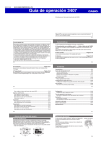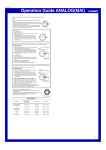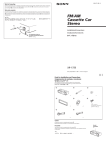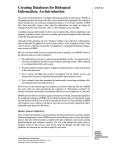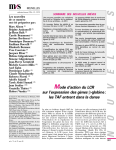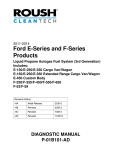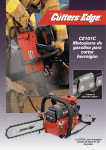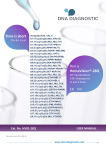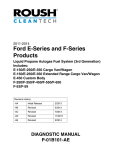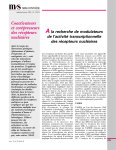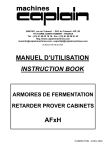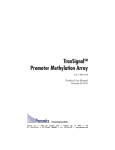Download Protein/DNA Arrays
Transcript
Protein/DNA Arrays (Spin Column Separation Version) User Manual Cat # MA1210, MA1211, MA1212 MA1213, MA1214 & MA1215 P/N 13299 Rev. B 032007 DRAFT May 18, 2007 4:28 pm PD ArrayTtile.fm Panomics, Inc. Protein/DNA Array Kit User Manual Copyright © Copyright 2006, Panomics, Inc. All rights reserved. Trademarks Hyperfilm and ECL are trademarks of GE Healthcare, Inc., FluorChem is trademark of AlphaInnotech, Inc. Citing Protein/DNA Arrays in Publications When describing a procedure for publication using this product, we would appreciate it if you would refer to it as the Protein/DNA Array Kit from Panomics If a paper cites the Protein/DNA Array kit and is published in a research journal, the lead author(s) may receive a travel stipend for use at a technology conference or tradeshow by sending a copy of the paper to our technical support group at [email protected] or via fax at (510) 818-2610. Disclaimer Panomics, Inc. reserves the right to change its products and services at any time to incorporate technological developments. This manual is subject to change without notice. Although this manual has been prepared with every precaution to ensure accuracy, Panomics, Inc. assumes no liability for any errors or omissions, nor for any damages resulting from the application or use of this information. DRAFT May 18, 2007 4:28 pm PD ArrayTtile.fm Contents About the User Manual . . . . . . . . . . . . . . . . . . . . . . . . . . . . . . . . . . . . . . . . . . . . . . . . . 5 Who Should Read this Manual. . . . . . . . . . . . . . . . . . . . . . . . . . . . . . . . . . . . . . . 5 What this Manual Covers . . . . . . . . . . . . . . . . . . . . . . . . . . . . . . . . . . . . . . . . . . . 5 Safety Warnings and Precautions . . . . . . . . . . . . . . . . . . . . . . . . . . . . . . . . . . . . 5 For More Information . . . . . . . . . . . . . . . . . . . . . . . . . . . . . . . . . . . . . . . . . . . . . . 5 About the TranSignal Protein/DNA Assay Kit . . . . . . . . . . . . . . . . . . . . . . . . . . . . . . . . 6 TranSignal Protein/DNA Assay . . . . . . . . . . . . . . . . . . . . . . . . . . . . . . . . . . . . . . 6 ............................................................... 6 TranSignal Protein/DNA Assay Kit Contents and Handling Conditions . . . . . . . . . . . . . 6 Kit Contents and Storage . . . . . . . . . . . . . . . . . . . . . . . . . . . . . . . . . . . . . . . . . . . 6 Kit Handling . . . . . . . . . . . . . . . . . . . . . . . . . . . . . . . . . . . . . . . . . . . . . . . . . . . . . 6 Required Materials and Equipment Not Provided . . . . . . . . . . . . . . . . . . . . . . . . . . . . . 7 Equipment . . . . . . . . . . . . . . . . . . . . . . . . . . . . . . . . . . . . . . . . . . . . . . . . . . . . . . 7 Sample Type Specific Materials . . . . . . . . . . . . . . . . . . . . . . . . . . . . . . . . . . . . . . 7 Introduction . . . . . . . . . . . . . . . . . . . . . . . . . . . . . . . . . . . . . . . . . . . . . . . . . . . . . 7 Princicple of the Technology . . . . . . . . . . . . . . . . . . . . . . . . . . . . . . . . . . . . . . . . 7 Overview of Assay Workflow . . . . . . . . . . . . . . . . . . . . . . . . . . . . . . . . . . . . . . . . . . . . . 8 ............................................................... 8 Guidelines for Assay Design and Analysis . . . . . . . . . . . . . . . . . . . . . . . . . . . . . . . . . . 9 Preparing Samples. . . . . . . . . . . . . . . . . . . . . . . . . . . . . . . . . . . . . . . . . . . . . . . . 9 General Guidelines . . . . . . . . . . . . . . . . . . . . . . . . . . . . . . . . . . . . . . . . . . . . . . . 9 Assay Procedures . . . . . . . . . . . . . . . . . . . . . . . . . . . . . . . . . . . . . . . . . . . . . . . . . . . . . 9 Before You Start . . . . . . . . . . . . . . . . . . . . . . . . . . . . . . . . . . . . . . . . . . . . . . . . . . 9 Preparing Nuclear Extracts . . . . . . . . . . . . . . . . . . . . . . . . . . . . . . . . . . . . . . . . . 9 Preparing the Membranes . . . . . . . . . . . . . . . . . . . . . . . . . . . . . . . . . . . . . . . . . . 9 Probe Mix . . . . . . . . . . . . . . . . . . . . . . . . . . . . . . . . . . . . . . . . . . . . . . . . . . . . . . 10 ISOLATING TF-BOUND PROBES. . . . . . . . . . . . . . . . . . . . . . . . . . . . . . . . . . . 10 HYBRIDIZATION . . . . . . . . . . . . . . . . . . . . . . . . . . . . . . . . . . . . . . . . . . . . . . . . .11 DETECTION . . . . . . . . . . . . . . . . . . . . . . . . . . . . . . . . . . . . . . . . . . . . . . . . . . . .11 RESULTS & ANALYSIS . . . . . . . . . . . . . . . . . . . . . . . . . . . . . . . . . . . . . . . . . . . 12 REFERENCES. . . . . . . . . . . . . . . . . . . . . . . . . . . . . . . . . . . . . . . . . . . . . . . . . . 12 APPENDIX I. . . . . . . . . . . . . . . . . . . . . . . . . . . . . . . . . . . . . . . . . . . . . . . . . . . . . . . . . 13 RECIPES AND INSTRUCTIONS . . . . . . . . . . . . . . . . . . . . . . . . . . . . . . . . . . . . 13 TranSignal Protein/DNA Arrays User Manual iii About the User Manual About the User Manual Who Should Read Anyone that has purchased a Protein/DNA Array Kit from Panomics to profile from 56 this Manual to 345 different Transcription Factors. ] What this Manual This manual provides recommendations and step-by-step procedures for the Covers following: ♦ Sample and assay preparation ♦ Assay procedure ♦ Troubleshooting ♦ Layouts Safety Warnings CAUTION All chemicals should be considered potentially hazardous. We recommend that and Precautions this product and its components be handled by those trained in laboratory techniques and be used according to the principles of good laboratory practice. For More For information about the Protein/DNA products mentioned in this manual, visit our Information website at www.panomics.com. Protein/DNA Arrays User Manual Page 5 About the Protein/DNA Assay Kit About the Protein/DNA Assay Kit Protein/DNA The Protein/DNA kit is a highthroughput profiling assay that has the ability to Assay mesaure the activation of multiple TF’s from a single sample . The cytokine panels for TranSginal Protein/DNA kits are available as:\ Array Name Cat. # # of TF’s ♦ PD Array I MA1210 56 ♦ PD Array II MA1211 96 ♦ PD Array III MA1212 94 ♦ PD Array IV MA1213 76 ♦ PD Array V MA1214 73 ♦ Combo Array MA1215 345 Protein/DNA Assay Kit Contents and Handling Conditions Kit Contents and The contains the following components. Shelf life of kit is six months from date of Storage receipt under proper storage conditions Box 1: Array Membranes and Hybridization Reagents (Store at 4 °C) ♦ Protein/DNA Array (3 each) ♦ Spin Column (3 each) ♦ Spin Column collection Tube (6 each) ♦ 1X Column Incubation Buffer (2 ml) ♦ 1X Colunm Wash Buffer (10 ml) ♦ Hybridization Buffer (15 ml) ♦ 20X SSC (32 ml) ♦ 20% SDS (15 ml) ♦ Streptavidin-HRP conjugate (60 µl) ♦ 4X Wash Buffer (45 ml) ♦ Solution I (750 µl) ♦ Solution II (750 µl) ♦ Solution III (8 ml) Box 2: Reaction Kit (Store at -20 °C) Page 6 ♦ Probe Mix (30 µl) ♦ 1X Column Elution Buffer (200 µl) Bring to room temperature before use ♦ Distilled H20, RNAse, DNAse free (500 µl) ♦ Control Nuclear Extract from HeLa Cells (5 µl) ♦ 2X Blocking Buffer (30 ml) ♦ 1X Detection Buffer (60 ml) ♦ 5X Pre-Treatment Buffer I (20 ml) ♦ 5X Pre-Treatment Buffer II (20 ml) Protein/DNA Arrays User Manual Protein/DNA Assay Kit Contents and Handling Conditions Additional ♦ Materials Required ♦ Materials and ♦ Euipment Panomics Nuclear Extraction Kit (Cat# AY2002) Deionized H20 0.5 ml and 1.5ml microfuge tubes ♦ Pipetman and tips ♦ Microcentrifuge ♦ Hybridization oven and bottles ♦ Plastic containers (~4.5” x 3.5”; equivalent to the size of a 200 µl pipete tip box) ♦ Shaker ♦ Plastic sheet protectors ♦ Hyperfilm™ ECL™ (Amersham, Cat # RPN3114K) ♦ Chemiluminescent Imaging system, FluorChem™ from Alpha Innotech Introduction Eukaryotic gene expression is regulated by a group of proteins called Transcription Factors (TFs). By interacting with specific DNA-Binding elements present in the promoters of certain genes, TFs modulate the frequency of transcriptional initiation. The expression or activity of TFs may be regulated in a cell-type , tissue specific, or cell cycle-dependent manner. Regulation can also be mediated by interactions with other proteins. Through different combinations of these regulatory mechanisms, eukaryotes are able to elicit a myriad of different gene expression patterns. The key to a full understanding of how gene expression is regulated is the analysis of the biochemical activity of TFs. Panomics’ Protein/DNA Arrays simplify the functional analysis of eukaryotic TFs. Our array-based technology is a significant improvement over cumbersome gel mobility-shift assays, which permit the characterization of only a single TF at a time. With these Protein/DNA Arrays, you can profile the activities of multiple TFs simultaneously. These arrays can be used to study TF activation in a variety of biological processes, including cell proliferation, differentiation, transformation, apoptosis, and drug treatment. We currently offer six versions of the TranSignal Protein/DNA Array. Version I for 56 transcription factors (TFs); Version II for 96; Version III for 94; Version IV for 76; Version V for 73; and the Combo Array for 345 TFs. These transcription factors are well characterized and widely available in published literature. Princicple of the Protein/DNA Arrays use a proprietary, patent-pending technology developed by Technology Panomics for the high-throughput analysis of TF activation. The procedure is simple and straightforward (Figure 1). Three basic steps are involved: (1) a set of biotin-labeled DNA binding oligonucleotides (Probe Mix) are preincubated with a nuclear extract of interest to allow the formation of protein/DNA complexes; (2) the protein/DNA complexes are separated from the free probes; and (3) the probes in the complexes are then extracted and hybridized to the Protein/DNAl Array. Each kit includes the reagents for HRP-based chemiluminescence detection. Protein/DNA Arrays User Manual Page 7 Overview of Assay Workflow Overview of Assay Workflow 1. Mixture of pre-labeled TF probes TF Probe 1 5' Biotin TF Probe 2 3' 5' Biotin TF Probe 3 3' 5' Biotin TF Probe 4 3' 5' Biotin 3' 2. Incubate with nuclear extract TF1 5' Biotin TF2 3' 5' Biotin TF3 3' 5' Biotin TF4 3' 5' Biotin 3' 3. Separation of protein/DNA complexes Spin column Bind Wash Elute 4. Hybridization Cis1 Cisn Cis2 Figure 1: Workflow diagram of the Protein/DNA Array Page 8 Protein/DNA Arrays User Manual Guidelines for Assay Design and Analysis Guidelines for Assay Design and Analysis General Guidelines ♦ Read this user manual and all product inserts before performing the assay. ♦ Store all reagents at the recommended temperatures. ♦ Use Panomics’ Nuclear Extraction Kit for best results. Assay Procedures Before You Start ♦ ♦ Preparing Nuclear ♦ Extracts ♦ ♦ Thaw Positive Control and sample nuclear extracts on ice. Thaw Probe mix on ice. We recommend using Panomics’ Nuclear Extraction Kit (Cat. #AY2002). The minimum protein concentration of nuclear extract should be 1.0 ug/ul or greater and we recommend using between 4–10 µg of Nuclear Extract Protein. You will need to adjust the amount of water accordingly when preparing the samples with the probe mix. When measuring protein concentration, we also recommend using the DC Protein assay from Bio-Rad (Lowry assay) with a plate reader or spectrophotometer. Preparing the In this Section, you will prepare the array membranes for use. If you are reusing Membranes membranes that have been previously stripped, skip steps , and begin from step 1.4. 1.1 Prepare Pre-Treatment Buffers I and II (see Appendix I for recipes) and warm the Hybridization Buffer to 42 °C in a water bath or incubator. If you notice a cloudy or soapy appearance for the Hybridization Buffer, make sure the particulates are completely dissolved before proceeding. It may require overnight heating in a water bath. 1.2 Place each array membrane into a hybridization bottle. Be sure to place the membrane in the hybridization bottle such that the spotted oligos face the center of the tube (away from the walls). Add 25 ml of 1X Pre-Treatment Buffer I to each bottle and place in a hybridization oven at 45 °C for 5 minutes. 1.3 Thoroughly decant the solution from each bottle. Add 25 ml of 1X Pre-Treatment Buffer II to each bottle and place in a hybridization oven at 45 °C for 10 minutes. 1.4 Decant the solution from each bottle. Rinse the entire surface of each membrane with distilled water (not provided), by filling each bottle approximately half full and swirling the bottle for 30 sec. Repeat this rinsing step two additional times and decant water after final rinse. 1.5 To each hybridization bottle, add 5 ml of prewarmed Hybridization Buffer (provided). Place each bottle into the rotating hybridization oven at 42 °C for 2 hr. If needed, you can stop at this point of the protocol and leave the membrane overnight at 42 °C. Protein/DNA Arrays User Manual Page 9 Assay Procedures Forming In this Section, you will allow the DNA probes to bind to transcription factors from Protein-DNA your nuclear extract. Complexes 2.1 For each nuclear extract sample, combine the following components into a sterile 0.5-ml microcentrifuge tube (* = provided): Nuclear extract (1-3 µg/µl) 5µl TranSignal Probe Mix* 10µl dH2O (RNase,DNase free)* 5µl Total Volume 20µl Note If the protein concentration of your nuclear extract is below the recommended range, replace the dH2O with additional nuclear extract. 2.2 Mix well by pipeting. Incubate samples for 30 min at 15 °C. IsolatingTF-Bound In this section, you will isolate the protein-bound probes from the non-bound probes. Probes All centrifuge steps should be carried out on a regular benchtop centrifuge, at 7,000 rpm at 4 °C, unless otherwise stated. 3.1 Wash Spin Column by adding 500 µl of chilled 1X Column Incubation Buffer and centrifuging at 10,000 rpm for 30 sec at 4 °C, or room temp. 3.2 Add 20 µl 1X Column Incubation Buffer to the TF-Probe mix, from Step 2.2. Transfer all of this mix into the center of the Spin Column. 3.3 Incubate the Spin Column on ice for 30 min. 3.4 Centrifuge column at 7,000 rpm for 30 sec at 4 °C and discard the flow through. 3.5 Place the Spin Column in a new Spin Column Collection Tube (provided). 3.6 Add 600µl of 1X Column Wash Buffer to the Spin Column and incubate for 10 min, on ice. 3.7 Centrifuge column at 7,000 rpm for 30 sec at 4 °C and discard the flow through. 3.8 Wash the column by adding 600 µl of 1X Column Wash Buffer to the Spin Column and centrifuging at 7,000rpm for 30 sec at 4 °C. 3.9 Repeat step 3.8 three more times. 3.10 Remove residual Wash Buffer by an additional centrifugation at 10,000 rpm for 30 sec at 4 °C 3.11 Add 60µl of 1X Column Elution Buffer to the center of the Spin Column and incubate at room temperature for 5 min. 3.12 Place the Spin Column in a clean 1.5 ml microcentrifuge tube and centrifuge for 1 minute at 10,000rpm at room temperature. 3.13 Place the microcentrifuge tube, containing the collected flow through, which contains the eluted probe, on ice and use for further steps. If needed, you can stop at this point and store the eluted probe at 20 °C overnight. Hybridization In this Section, you will hybridize the eluted, labeled probe prepared in Section 3 to the array membrane prepared in Section 1. Page 10 Protein/DNA Arrays User Manual Assay Procedures 4.1 Denature the eluted probe (from step 3.13) by heating it at 95 °C for 3 min and quickly chill in ice for 2 min. Add the eluted probe to each hybridization bottle and hybridize at 42 °C overnight in a rotating hybridization oven 4.2 Decant the hybridization mixture from each hybridization bottle from Step 4.1 and wash each membrane as follows (* = See Appendix I for recipes): 4.3 Add 50 ml of prewarmed Hybridization Wash I*, incubate at 42°C for 20 min in a rotating hybridization oven. Decant liquid and repeat wash. 4.4 Add 50 ml of prewarmed Hybridization Wash II*, incubate at 42 °C for 20 min in a rotating hybridization oven. Decant liquid and repeat wash. Detection Important: Do not allow the membrane to dry during the detection. 5.1 Using forceps, carefully remove each membrane from its hybridization bottle and transfer to a clean container containing 20 ml of 1X Blocking Buffer; each membrane needs its own container. (We use a container that is equivalent to the size of a 200-µl pipet-tip container, ~4.5" x 3.5".) 5.2 Block the membrane by incubating at room temperature with the 1X Blocking Buffer for 15 min with gentle shaking. 5.3 Remove 1 ml of the 1X blocking buffer to a clean microcentrifuge tube. Dilute 20 µl of the stock Streptavidin-HRP conjugate with 1 ml of the 1X Blocking Buffer. Vortex the diluted streptavidin-HRP and transfer back into the 1X Blocking Buffer from Step 5.2 (containing the membrane). Add the diluted conjugate to the container, making sure not to pour directly on the membrane. Continue shaking the membrane for 15 min at room temperature. 5.4 Decant the diluted Streptavidin-HRP solution. Wash each membrane three times at room temperature with 20 ml of 1X Wash Buffer, each for 8 min. 5.5 Add 20 ml of 1X Detection Buffer to each membrane and incubate at room temperature for 5 min. 5.6 Overlay each blot with 2.5 ml of Working Substrate Solution, prepared by mixing the following, in order: 250 µl Solution I with 250 µl Solution II. Briefly vortex and add 2.0 ml Solution III. Thoroughly mix. Using a plastic sheet protector or overhead transparency film (do not use thin plastic cling wraps as these wrinkle and lead to uneven detection across the membrane). Place each membrane on a plastic sheet. Then, pipet 2.5 ml of the mixed substrate solution onto each membrane and overlay each with a second plastic sheet on a flat surface as quick as possible. Ensure that substrate is evenly distributed over the membrane with no air bubbles. Incubate at room temperature for 5 min. 5.7 Remove excess substrate by gently applying pressure over the top sheet. Using a paper towel, remove excess substrate that might be remaining on the surface of the sheets. Expose the membranes using either Hyperfilm ECL (2-10 min) or a chemiluminescence imaging system (5-15 min), such as the FluorChem imager from Alpha Innotech Corp. In either case, we recommend that you try several different exposure times. 5.8 Obtain quantitative analysis, if desired. If you are using a chemiluminescence imaging system, follow the instructions that are provided with that system’s software. If you are using Hyperfilm ECL, you will need to scan the film to obtain numerical data for comparison. Protein/DNA Arrays User Manual Page 11 Assay Procedures Results & Analysis TranSignal Arrays give you quick answers when you want to identify those activated transcription factors through comparison of two (or more) samples. Follow these guidelines to analyze your results: 6.1 Acquire the images using either x-ray film or a chemiluminescence imaging system. 6.2 Adjust the exposure time such that the majority of the positve control spots have equal signal intensity at the same exposure time. 6.3 When comparing mutliple blots, ensure that the control spots have a similar intensity. Stripping Note: We do not encourage stripping the array membranes more than two times. Procedure 7.1 Wash membranes in 0.4M NaOH at 45 °C for 30 min. 7.2 Wash membranes in 0.2M Tris-HCL, pH 7.6, 0.1X SSC, and 0.1% SDS at 45 °C for 15 min. 7.3 To ensure that stripping was successful, follow the standard chemiluminescence detection procedure as described in the user manual. 7.4 After detection, wash the membrane twice in 1X TBST with 0.1%SDS at 42 °C for 30 min. 7.5 Membranes are ready for hybridization or air dry the membrane at room 7.6 Store dry membrane protected between paper at room temperature unil ready for further use. Recipe for 10X TBST 1M Tris-HCL pH 7.5, 1.5M NaCl, 0.5% Tween-20 Possible Problems and Recommended Solutions Observation Possible Cause Recommended Action Uneven Background Substrate is note evenly distributed on the membrane Do not use thin cling wrap materials during the overlay procedure Exposure Time to Short Re-detect with substrate that is evenly covering the membrane surface Incubation with substrate is too long Incubate with shorter time Non-specific protein bound to membrane Increase blocking or washing times. Not enough protein was used in the assay. Carefully measure the concentration of the nuclear extract using a Lowry or Bradford assay High background Signal is too weak Page 12 Protein/DNA Arrays User Manual Assay Procedures Observation Possible Cause Recommended Action Don’t see difference between treated and untreated samples Confirm concentration of nuclear extract Carefully measure concentration Cells cultured with growth factors in serum Culture cells overnight without serum prior to treatment. TF not activated Confirm with EMSA References 1. Chodosh, L.A., Olesen, J., Hahn, S., Baldwin, A.S., Guarente, L., and Sharp, P.A. (1988) A yeast and a human CCAAT-binding protein have heterologous subunits that are functionally interchangeable. Cell 53:25–35. 2. Zeng, G., L., Gao, L., Xia, T., Tencomnao, T., and Yu, R. K. (2002) Characterization of the 5’-flanking fragment of the human GM3-synthase gene. Biochimica et Biophysica Acta 93745:1–6. 3.Miyoshi, K., Rzucidlo, S. J., Pratt, S. L., and Stice, S.L. (2002) Improvements in Cloning Efficiencies May Be Possible by Increasing Uniformity in Recipient Oocytes and Donor Cells. Biology of Reproduction, in press. 4. Govindarajan, B., Bai, X., Cohen, C., Zhong, H., Kilroy, S., Moses, M. and Arbiser, J. (2003) Malignant transformation of melanocytes to melanoma by constitutive activation of MAP kinase kinase signaling. J Biol Chem. Electronically published 1/03 - see www.jbc.org. 5. Wheeler, M., Smutney, O., Check, J., Rusyn, I., Schulte-Hermann, R. and Thurman, R. (2003) Impaired Ras membrane association and activation in PPARa knockout mice after partial hepatectomy. Am J Phsiol Gastrointest Liver Physiol 284:302–312. 6. Dignam, J.D., Lebovitz, R.M., and Roeder, R.G. (1983) Accurate transcription initiation by RNA polymerase II in a soluble extract from isolated mammalian nuclei. Nucleic Acids Research 11:1475–1489. Protein/DNA Arrays User Manual Page 13 APPENDIX I APPENDIX I RECIPES AND •75 ml of 1X Pre-Treatment Buffer I INSTRUCTIONS Warm 5X Pre-Treatment Buffer I to room temperature. If precipitate is visible, warm gently to fully dissolve solution, and allow to cool to room temperature. To 60 mL of deionized H2O, add 15 ml of 5x Pre-Treatment Buffer I. Mix well. •75 ml of 1X Pre-Treatment Buffer II Warm 5X Pre-Treatment Buffer II to room temperature. If precipitate is visible, warm gently to fully dissolve solution, and allow to cool to room temperature. To 60 mL of deionized H2O, add 15 ml of 5x Pre-Treatment Buffer II. Mix well. •300 ml of 2X SSC/0.5% SDS (Hybridization Wash I) To 262.5 ml of deionized H2O, add 30 ml of 20X SSC (provided) and 7.5 ml of 20% SDS (provided). Mix well. •300 ml of 0.1X SSC/0.5% SDS (Hybridization Wash II) To 291 ml of deionized H2O, add 1.5 ml of 20X SSC (provided) and 7.5 ml of 20% SDS (provided). Mix well. •60 ml of 1X Blocking Buffer To 30 ml of deionized H2O, add 30 ml of 2X Blocking Buffer (provided). Mix well and store at 4°C. •180 ml of 1X Wash Buffer To 135 ml of deionized H2O, add 45 ml of 4X Wash Buffer (provided). Mix well and store at room temperature. Page 14 Protein/DNA Arrays User Manual TranSignal Protein/DNA Array Grid TranSignal Protein/DNA Array Grid Photocopy this page onto a separate piece of paper or transparency film. Note that the notch is on the upper-right hand corner of the grid. 1 2 3 4 5 6 7 8 9 10 11 12 13 14 15 16 17 18 19 20 21 22 23 24 A B C D E F G H I J K L M N O P 1 2 3 4 5 6 7 8 9 10 11 12 13 14 15 16 17 18 19 20 21 22 23 24 A B C D E F G H I J K L M N O P 1 2 3 4 5 6 7 8 9 10 11 12 13 14 15 16 17 18 19 20 21 22 23 24 A B C D E F G H I J K L M N O P 1 2 3 4 5 6 7 8 9 10 11 12 13 14 15 16 17 18 19 20 21 22 23 24 Protein/DNA Arrays User Manual A B C D E F G H I J K L M N O P Page 15 TranSignal Protein/DNA Array Grid Page 16 Protein/DNA Arrays User Manual TranSignal Protein/DNA Arrays User Manual Page 15 TR N 2 TR SRE SRE E2F-1 3 4 TR/DR-4 TR/DR-4 TR/DR-4 TR/DR-4 SRE SRE E2F-1 6 USF-1 (1) USF-1 (1) USF-1 (1) USF-1 (1) 5 Stat-1 Stat-1 Stat-1 Stat-1 PRE PRE 11 Stat-3 7 8 VDR/DR-3 VDR/DR-3 VDR/DR-3 VDR/DR-3 Stat-3 Stat-3 9 HSE HSE Stat-4 Stat-4 10 HSE HSE Stat-4 Stat-4 11 MRE MRE Stat-5 Stat-5 SIE RAR/DR-5 RAR/DR-5 RXR/DR-1 RXR/DR-1 Stat-3 12 13 14 15 16 12 MRE MRE Stat-5 Stat-5 SIE SIE AP-1 (2) AP-1 (2) AP-2 (2) AP-2 (2) AP-1 (2) AP-1 (2) AP-2 (2) AP-2 (2) 13 Stat-6 Stat-6 15 TFIID Stat-6 14 TFIID Stat-6 16 TFIID TFIID O N M L K J Smad/SBE Smad/SBE SMAD-3/4 SMAD-3/4 H G F E D C B A I 17 18 17 Smad/SBE Smad/SBE SMAD-3/4 SMAD-3/4 CEBP CDP c-Myb CDP CBF CBF c-Myb (1) CEBP CDP c-Myb CBF CBF CDP c-Myb (1) Ets Ets-1/Pea-3 Ets-1/Pea-3 FAST-1 GAS/ISRE GAS/ISRE FAST-1 (1) (1) (1) Ets1/Pea3 Ets1/Pea3 FAST-1 Ets FAST-1 GAS/ISRE GAS/ISRE (1) (1) (1) NF-1 NF-1 MEF-1 MEF-2 Myc/Max Myc/Max MEF-2 (1) (1) (1) (1) (1) NF-1 NF-1 MEF-2 MEF-1 MEF-2 Myc/Max Myc/Max (1) (1) (1) (1) (1) Pax-5 Pax-5 p53 OCT p53 Pbx-1 Pbx-1 (1) (1) (1) (1) (1) Pax-5 p53 Pax-5 OCT p53 Pbx-1 Pbx-1 (1) (1) (1) (1) (1) 10 SIE NFkB (1) NFkB (1) NFkB (1) NFkB (1) CEBP (1) CEBP (1) Ets (1) Ets (1) MEF-1 (1) MEF-1 (1) OCT (1) OCT (1) 9 RAR/DR-5 RAR/DR-5 RXR/DR-1 RXR/DR-1 IRF-1 IRF-1 ER ER Brn-3 Brn-3 8 IRF-1 IRF-1 ER ER Brn-3 Brn-3 7 Array V: Grey rows and columns are spotted with biotinylated DNA and are used as postive controls for the assay. Pink shaded Rows are the same TF’s as the TF’s above in the white rows except that they are spotted at a 1:10 dilution. For some Transcription Factors, mutliple consensus sequences for the same TF have been publsihed in the literature and where appropriate, we have provided those variations on our arrays. For the TF’s with mutliple consensus sequences, they have been denoted with numbers in parenthesis, ie (1), (2), (3) etc. To obtain the consensus sequences and references for the TF’s, used in our arrays, please call our Technical Support group at 877-726-6642 or email at [email protected]. 1 TR M O Sp-1 Sp-1 L TR Sp-1 Sp-1 K J I H NFAT-1 (1) NFAT-1 (1) Pit-1 (1) Pit-1 (1) GATA F G GATA AR 6 EGR (1) EGR (1) HNF-4 (1) HNF-4 (1) NF-E2 (1) NF-E2 (1) AR 5 EGR (1) EGR E2F-1 E2F-1 (1) HNF-4 GR/PR GR/PR GATA (1) HNF-4 GR/PR GR/PR GATA (1) NF-E2 NFAT-1 NF-E1/YY1 NF-E1/YY1 (1) (1) NFAT-1 NF-E1/YY1 NF-E1/YY1 NF-E2 (1) (1) Pit-1 PPAR PPAR PRE (1) (1) (1) PPAR Pit-1 PPAR PRE (1) (1) (1) AP-2 (1) AP-2 (1) 4 AR AP-2 (1) AP-2 (1) 3 AR AP-1 (1) AP-1 (1) CREB (1) CREB (1) AP-1 (1) AP-1 (1) CREB (1) CREB (1) E D C B A 2 1 Array I: Schematic Diagram of TranSignal™ Protein/DNA Array I Page 16 TranSignal Protein/DNA Arrays User Manual 6 MZF-1 PARP RREB (1) HNF-3 ISRE (3) MUSF-1 p300 PPAR (3) ISRE (3) MUSF-1 p300 PPAR (3) HIF-1 ISRE (2) MT-Box ORE PPAR (2) HIF-1 ISRE (2) MT-Box ORE PPAR (2) G H I J K M 2 3 4 TCF/LEF 8 9 10 5 6 XBP-1 RREB (1) PARP MZF-1 L-III BP 8 PAX-2 (1) RREB (2) XRE (1) PAX-2 (1) RREB (2) XRE (1) 7 NF-Y KKLF HNF-4 NF-Y KKLF HNF-4 10 11 ZIB ZIA ZIA 9 SAA PAX-4 NPAS-2 RSRFC4 PAX-3 Nkx-2.5 MEF2 (2) Ikaros HFH-2 GATA-3 13 14 ZIC ZIC ZIB 12 Skn HBS/ XBP-1 PAX-6 (1) MEF-3 Skn HBS/ XBP-1 PAX-6 (1) MEF-3 SAA PAX-4 NPAS-2 MEF2 (2) IRF-1/2 Ikaros IRF-1/2 HFH-3 (1) HFH-3 (1) HFH-2 Freac-4 E4F/ATF GATA-4 Freac-4 E4F/ATF DR-0 15 ZID SRY (1) PAX-8 NZF-3 16 ZID SRY (1) PAX-8 NZF-3 MSP-1 17 M L K J I H G ISRE (1) ISRE (1) MSP-1 F E D C B A HFH-8 GATA-6 Freak-7 Elk-1 DR-1 17 HFH-8 GATA-6 Freak-7 Elk-1 DR-1 CdxA/ NKX2 β-response β-response CdxA/ element element NKX2 DR-0 16 14 15 13 GATA-4 GATA-3 E4BP4 (1) Freac-2 (2) E4BP-4 (1) Freac-2 (2) RSRFC4 PAX-3 Nkx-2.5 MEF2 (1) HFH-1 (1) HNF-4/ COUP-TF HFH-1 (1) HNF-4/ COUP-TF MEF2 (1) HBS/HAS HBS/HAS GATA-2 GATA-1/2 GATA-1/2 GATA-2 E47 Freac-2 (1) Afxh/ Foxo4 Afxh/ Foxo4 E47 Freac-2 (1) DR-5 DR-5 c-REL AP-4 (1) AP-4 (1) c-REL 12 11 Array II: Grey rows and columns are spotted with biotinylated DNA and are used as postive controls for the assay. For some Transcription Factors, mutliple consensus sequences for the same TF have been publsihed in the literature and where appropriate, we have provided those variations on our arrays. For the TF’s with mutliple consensus sequences, they have been denoted with numbers in parenthesis, ie (1), (2), (3) etc. To obtain the consensus sequences and references for the TF’s, used in our arrays, please call our Technical Support group at 877-726-6642 or email at [email protected]. 1 Tax/CREB Tax/CREB TCF/LEF Gfi-1 GAG XBP-1 L-III BP HAS HAS Gfi-1 F L HNF-3β HNF-3β GAS GAS GAG E HNF-3 FKHR (2) GATA-1 (1) HBS (1) FKHR (2) GATA-1 (1) HBS (1) FKHR (1) FKHR (1) EVI-1 D EVI-1 DR-3 DR-2 DR-2 C DR-4 DR-4 DR-3 CEF-2 (1) CEF-1 (1) CEF-1 (1) CEF-2 (1) 7 AP-3 ANG-IRE Antioxident Antioxident AP-3 (1) (1) RE RE COUP-TF COUP-TF CETP/CRE CETP/CRE CREB-BP1 CREB-BP1 (1) (1) 5 B 4 ADR-1 AHR/ARNT AHR/ARNT ANG-IRE 3 ADR-1 2 A 1 Array II: Schematic Diagram of TranSignal™ Protein/DNA Array II TranSignal Protein/DNA Arrays User Manual Page 17 3 M L K 2 3 4 WTI (2) WTI (2) 6 WTI (3) WTI (3) 5 TFE-3 TFE-3 7 X2 BP 8 X2 BP Tf-LF SIF-1 MTF (1) NF-Gma (2) PEBP-2 (1) LCR-F1 9 XBP-1/ X2 BP TGT-3 10 XBP-1/ X2 BP TGT-3 SIF-2 PPUR (1) PPUR (1) SIF-2 NF-IL-2 MyoD LF-A1 HOXD8 (1) HEN-1 CSBP CCAC AML-1 10 NF-IL-2 MyoD LF-A1 HOXD8 (1) HEN-1 CSBP CCAC AML-1 9 12 AREB-6 13 11 ZNF174 TIF-1 SIF-3 NF-Y (2) PPUR (2) MyoG 12 ZNF174 TIF-1 SIF-3 NF-Y (2) PPUR (2) MyoG ARP 15 Pur-1 NRF-1 MyTI HOXD9/10 LyF (1) HiNF 14 TREF-1/2 TREF-1/2 13 ARP 16 15 v-Maf 16 v-Maf SRF/SAP PYR LyF (2) MZF-1 (1) P53 (3) LyF (2) MZF-1 (1) P53 (3) PYR ICSBP HLF ICSBP HLF CD28RC Cdx-2 Cdx-2 (2) E12 EBP-40/45 EBP-40/45 (1) AREB-6 14 SP-1/ASP SP-1/ASP SRF/SAP Pur-1 NRF-1 MyTI CD28RC CD28RC CD28RC (2) (1) (1) E12 CTCF CTCF (1) HFH-8/ HFH-8/ HiNF HNF3 LUN HNF3 LUN HOXD8 HOXDHOXD8 (2) 9/10 (2) LyF LR-1 LR-1 (1) AP-2/YY1 AP-2/YY1 11 Array III: Grey rows and columns are spotted with biotinylated DNA and are used as postive controls for the assay. For some Transcription Factors, mutliple consensus sequences for the same TF have been publsihed in the literature and where appropriate, we have provided those variations on our arrays. For the TF’s with mutliple consensus sequences, they have been denoted with numbers in parenthesis, ie (1), (2), (3) etc. To obtain the consensus sequences and references for the TF’s, used in our arrays, please call our Technical Support group at 877-726-6642 or email at [email protected]. 1 TCE TCE Tf-LF SYR (2) WTI (1) PEBP SYR (2) WTI (1) PEBP SIF-1 NF-4FA NF-4FA RFX-1/2/3 RFX-1/2/3 RIPE-3a1 RIPE-3a1 (1) (1) MAZ (2) MAZ (2) RB LCR-F1 RB J KTP-1 PEA3/HIP PEA3/HIP p55 I H KTP-1 HOXD 8/9/10 HOXD 8/9/10 p55 LyF-1 (3) MZF-1 (2) KPF-1 HOX4C HOX4C NF-Gma (1) Isl-1 F HNF-1A H4TF CREB-2 CCAAT AIC/CBF 8 H4TF NF-Gma (1) HMG E ELF ELF CREB-2 MTF (1) NF-Gma (2) PEBP-2 (1) LyF-1 (3) MZF-1 (2) EKLF (1) D CPE CPE CCAAT AIC/CBF 7 MTB-Zf KPF-1 Isl-1 CEA C CACC AFP-1 6 CACC AFP-1 5 MTB-Zf HNF-1A HMG ATF/CRE (1) B ADD-1 ADD-1 G 4 AF-1/ AF1/ ARP-1 ARP-1 ATF ATF ATF/CRE (2) (2) (1) CP1/CTF/ CP1/CTF/ CEA CBTF CBTF EKLF EKLF EKLF (1) (2) (2) 2 A 1 Array III: Schematic Diagram of TranSignal™ Protein/DNA Array III 17 17 M L K J I H G F E D C B A Page 18 TranSignal Protein/DNA Arrays User Manual AAF L ABF-1 3 ABF-1 4 7 ACP BP 6 ACF 5 ACF AP-2 (2) AP-2 (2) 2 3 4 LSF 5 LXRE-1 6 LXRE-1 7 8 9 CP-1B CBFB ATF-α ALF-1 11 CP-1B CBFB ATF-α ALF-1 12 α-PAL 14 CP-1 CP-1 βM-globin βM-globin Factor B1 Factor B1 CBF CBF (2) (2) α-PAL 13 10 11 12 13 14 E2F-1 E2F-1 E2 E2 (2) (2) EGR-1 EGR-2 EIL-1/2/3 EIL-1/2/3 EGR-2 (2) (2) (2) GATA-1 GBF-1/2/3 GBF-1/2/3 GKLF GKLF (2) HY5 HY5 HiNF-B/ HNF-1 HNF-1 HiNF-D3 HiNF-D3 H1TF1 a/b/c a/b/c HSF (3) HSF/HTF HSF/HTF IFI-56KBP IFI-56KBP proximal LF-A1 LF-A2 LF-A2 LF-B2 LF-B2 (2) MBP-1 MBP-1 MBP-1 (1) (2) (2) AIC2/3/4 ATFadelta CEBP (5) COUP-TF (2) E12/E47 10 9 AIC2/3/4 ATFadelta CEBP (5) COUP-TF (2) Array IV: Grey rows and columns are spotted with biotinylated DNA and are used as postive controls for the assay. For some Transcription Factors, mutliple consensus sequences for the same TF have been publsihed in the literature and where appropriate, we have provided those variations on our arrays. For the TF’s with mutliple consensus sequences, they have been denoted with numbers in parenthesis, ie (1), (2), (3) etc. To obtain the consensus sequences and references for the TF’s, used in our arrays, please call our Technical Support group at 877-726-6642 or email at [email protected]. 1 LSF c-Myc apo A1 PR CEBP (4) ACP BP 8 dioxin E12/E47 receptor EGR-1 EGF (2) BP gastrin EGF GATA-1 (2) RE HiNF-A HiNF-B/ H1TF1 HSF HSF (3) (2) distal proximal lactoferrin LF-A1 BP (2) MBP-1 MASH-1 MASH-1 (1) AP-3 AP-3 AP-4 AP-4 apo A1 (2) (2) (2) (2) PR CEBP CEPB CEPB CEBP CEBP BZP BZP (4) (3) (3) (2) (2) c-fos c-fos c-myb c-myb c-Myc c-Ets-1 c-Ets-1 enhancerBP enhancerBP (2) (2) dioxin CREB CREB DE-1 DE-1 CYP1A1 CYP1A1 receptor (2) (2) E4BP4 E4BP4 EBP-C2/NF EBP-C2/NF EGF EBP-80 EBP-80 (2) (2) muE3/YEB3 muE3/YEB3 BP ETV4/ Fra-1/JUN Fra-1/JUN gastrin EGF ETV4/ ETF ETF E1A-F E1A-F RE HFH-11β/ HFH-11β/ HFH-1 HFH-1 H4TF-1 H4TF-1 HiNF-A 11α 11α (2) (2) HSF HNF-4α HNF-4α HOXA4 HNF-1 HNF-1 HOXA4 (2) distal 2/1 2/1 lactoferrin IL-6 RE-BP IL-6 RE-BP ISGF kBF-A kBF-A ISGF BP AAF 2 K LH2/Lim1 LH2/Lim1 J I H G F E D C B A 1 Array IV: Schematic Diagram of TranSignal™ Protein/DNA Array IV 15 15 L K J I H G F E D C B A TranSignal Protein/DNA Arrays User Manual Page 19 SAP-1b Stat-5b tPA BP XBP-1 (2) SAP-1b Stat-5b tPA BP XBP-1 (2) H I J K L Snail 3 4 Surf-2 Surf-2 (2) (2) transferrin transferrin BP BP XRE XRE (2) (2) Snail TTF-1 (1) TTF-1 (1) 5 6 YB-1 T3R YB-1 OCT (3) PBGD BP PCF ODC PCF ODC 7 TTF-1 (2) Tat 8 TTF-1 (2) Tat TFE-3L 9 10 TxREF NF TxREF NF III III TFE-3L RAR/RXR RAR/RXR RFX-1/2/3 RFX-1/2/3 CF1/MB67 CF1/MB67 SRF SRF SRF SRF SPERM-1 (1) (1) (2) (2) PUR T3R SPERM-1 PUR PO-B PO-B PU.1 PAX-6 PAX-6 PU.1 OCT (3) PBGD BP OCT (2) OCT (2) NF-Atx PRDI-BFc PRDI-BFc PRDII-BF1 PRDII-BF1 NF-Atx NF-1 (2) NF-E2 (2) NF-1 (2) NF-E2 (2) NCAM BP NCAM BP NF-Atp NFAT-1 (2) N-ras BP PAX-5 (2) Pit-1 (2) NFAT-1 (2) N-ras BP PAX-5 (2) Pit-1 (2) Mfh-1 10 Mfh-1 9 MEF-2a 8 MEF-2a 7 NF-Atp myc/CF1 myc/PRF myc/PRF MDBP (2) 6 myc/CF1 MDBP (2) 5 MDBP (1) 4 MDBP (1) 3 12 13 14 11 URE TFEB SSAP 12 URE TFEB SSAP RORE PTF-1β PREB PREB RORE PEPCK PR GR PEBP-2 (2) 13 WAP BP 15 WAP BP Thy-1 BP Stat-1/3 Stat-1/3 Thy-1 BP RVF PTF-1β PEPCK PR GR PAX1 NFkB (2) NF-A3 RVF PAX1 PEBP-2 (2) NFkB (2) NF-A3 NFE-6/ CP-1 p53 (2) NF-1L NFE-6/ CP-1 p53 (2) NF-1L MHC gene MHC gene msx-1/2/3 msx-1/2/3 PR W Box PR W Box 11 Array V: Grey rows and columns are spotted with biotinylated DNA and are used as postive controls for the assay. For some Transcription Factors, mutliple consensus sequences for the same TF have been publsihed in the literature and where appropriate, we have provided those variations on our arrays. For the TF’s with mutliple consensus sequences, they have been denoted with numbers in parenthesis, ie (1), (2), (3) etc. To obtain the consensus sequences and references for the TF’s, used in our arrays, please call our Technical Support group at 877-726-6642 or email at [email protected]. PR= Promoter, BP= Binding Protein. 2 PTF-1 PTF-1 G F E 1 NFkB (3) PAX-2 (2) Pit-1 (1) NFkB (3) PAX-2 (2) Pit-1 (1) D NF-A mck PR E1 Myb (2) mck PR E1 Myb (2) NF-A C B A 2 1 16 15 Array V: Schematic Diagram of TranSignal™ Protein/DNA Array V 17 L K J I H G F E D C B A Page 20 TranSignal Protein/DNA Arrays User Manual GATA IRF-1 MEF-1 (1) MEF-2 (1) Myc-Max AP-2 (1) AR Bm-3 CEBP (1) CBF (1) CDP c-Myb (1) A B C D E F H I 5 HIF-1 CEF-2 (1) Stat-1 Stat-3 Stat-4 Stat-5 Beta-RE NFkB (1) OCT (1) p53 (1) PAX-5 (1) ERE Ets (1) Ets/PEA3 (1) Fast-1 M N O 4 HFH-1 (1) FKHR (2) AP-4 (1) 5 6 HFH-2 MEF-3 GFI-1 FKHR (1) AP-3 (1) Afxh/ Foxo4 KKLF GATA-6 EVI-1 Antioxident RE 7 MSP-1 L-III BP GATA-4 ISRE (2) ISRE (1) IRF-I/2 ANG-IRE Elk-1 E4BP-4 GATA-2 (1) 8 PAX-8 PAX-6 (1) PAX-4 9 HEN-1 HMG HLF HiNF CPE 10 12 11 NF-4FA MZF1 (2) MZF1 (1) MyTI MyoG MAZ 12 13 PEBP-2 (1) PEBP p55 14 Tf-LF TFE3 SRF SAP TCE p53 (3) LyF (2) LyF (3) SP-1/ ASP SIF-3 SIF-2 NRF-1 NF-Y (2) NFIL-2 SIF-1 RIPE3a1 RFX-1/ 2/3 (2) RB PYR LyF (1) LR-1 LF-A1 TIF-1 TGT-3 15 alphaPAL AP-2 (2) 16 CBF (2) CBFB CEBP (5) CEBP (4) CEBP (3) 16 HiNF-B/ MBP-1 HITF-1 (1) LXRE-1 LSF LH2/ Lim-1 LF-B2 LF-A2 HFN-1 a/b/c EGR-2 (1) 17 MDBP (2) MDBP (1) 18 IL-6RE-BP 19 Mfh-1 HOXA-4 MEF-2a EGR-1 HNF-4a (2) 2/1 EGF BP MBP-1 EBP-80 HiNF/D3 (2) E2 EILALF-1 c-Fos BP 1/2/3 15 HFH-1 (2) HFH11B/11a H4TF-1 GKLF E12/E47 HiNF-A DE-1 CYP1A1 CRE (2) β M glob factor B1 CEBP (2) kBF-A ISGF 19 CP-1B GBF-1/2 LF-A1 /3/HY5 (2) CP-1 BZP Fra-1/ JUN ETF 18 COUP-TF GATA-1 Lacto(2) (2) ferrin BP c-Myc c-myb BP 17 ATF-a ATF adelta ACPBP c-Ets-1 ACF ABF-1 AAF ZNF174 XBP-1 X2 BP X2 BP WTI (3) WTI (2) WTI (1) v-Maf Pur-1 TREF-1/2 AP-3 (2) PPUR (2) PPUR (1) MTF (1) MyoD 14 13 LCR-F1 NF-Gma (1) KTP-1 KPF-1 Isl-1 ICSBP HOXD9/10 HOXD-8 (2) HOXD-8 (1) HOXD- MTB-Zf 8/9/10 HOX4C CP1/CTF HNF-1A /CBTF CEA Cdx-2 CD28RC (2) CD28RC HFH-8/3 /LUN (1) CCAC AIC/CBF CREB-2 AFP-1 AF-1 ADD-1 XRE (1) PAX-2 (1) PAX-3 XBP-1 TCF/LEF Tax/ CREB PARP p300 ORE ELF EKLF (2) EKLF (1) EBP40/45 E12 (1) CTCF CSBP 11 20 21 p53 (2) ODC OCT (3) Snail RVF RORE PO-B PEPCK PR PCF 20 NFkB (2) 21 PRDIIBF1 24 I TTF-1 (1) 22 Surf-2 (2) 23 YB-1 P O N XBP-1 (2) L K M v-rel 50-55k URE J H G F E D C B A Stat-1/3 WAP BP SSAP SRF (2) 24 Transferrin BP Thy-1BP TFEB TFE-3L TEF1 TEF-1/ AP-5 PBGD SPERM-1 TxREF NF-III BP PAX-6 (2) PAX-5 (2) PAX-2 (2) RFX-1/ 2/3 (3) PUR PU.1 PTF-1 NF-E6/ PRDI-BFc Stat-5b CP1 NF-E2 (2) NF-Atx NF-Atp NFAT-1 (2) NF-A3 NF-1/L NF-1 (2) NCAM BP PAX-1 myc/PRF myc/CF1 Myb (2) Tat 23 msxN-ras BP PTF-1β 1/2/3 22 T3R NFkB (3) PREB MHC W box ComboArray: Grey rows and columns are spotted with biotinylated DNA and are used as postive controls for the assay. For some Transcription Factors, mutliple consensus sequences for the same TF have been publsihed in the literature and whe appropriate, we have provided those variations on our arrays. For the TF’s with mutliple consensus sequences, they have been denoted with numbers in parenthesis, ie (1), (2), (3) etc. To obtain the consensus sequences and references for the TF’s, used in our arrays, please call our Technical Support group at 877-726-6642 or email at [email protected]. RE= Respnose Element BP= Binding Protein P L 3 SRE NF-E2 (1) EGR (1) K 2 Sp-1 AhR/Amt E4F/ATF GATA-3 NF-E1/ YY1 E2F-1 (1) J 1 SMADADR-1 3/4 NFAT-1 (1) CREB (1) GATA1/2 Ikaros CCAAT SRY (1) ATF (2) GATA-1 HNF-4/ NZF-3 (1) COUP-TF SAA CACC MRE E47 ARP AREB-6 AML-1 10 RSRFC4 ATF/CRE RREB (1) PPAR (3) PPAR (2) 9 Skn HNF-3 Nkx-2.5 (2) NF-Y (1) MZF-1 MUSF-1 MT-Box 8 HNF-4 NPAS-2 (2) GAS SMAD/ SBE c-Rel CREBBP-1 COUP-TF GAG (1) HNF-3 CETP-CRE Freac-7 (1) Freac-4 Freac-2 HFH-8 (2) NF-1 (1) G 7 Freac-2 (1) HFH-3 6 CEF-1 (1) CdxA/ NKX2 HSE VDR/ DR-3 USF-1 (1) RAR/ DR-5 RXR/ DR-1 TR/ DR-4 TR PPAR (1) PRE TFIID Stat 6 4 Pit-1 (1) Pbx1 3 SIE GR/PR 2 GAS/ ISRE 1 AP-1 (1) ComboArray: Schematic Diagram of Protein/DNA ComboArray






















